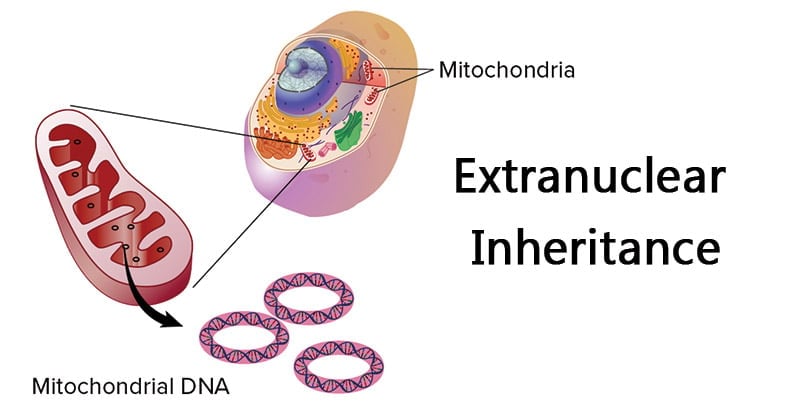- Though, the genes of nuclear chromosomes have a significant and key role in the inheritance of almost all traits from generations to generations, they altogether cannot be considered as the sole vehicles of inheritance.
- Certain experimental evidences suggest the occurrence of certain extranuclear genes or DNA molecules in the cytoplasm of many prokaryotic and eukaryotic cells.
- Bacterial cells such as E. coli possess a single main chromosome in the nucloid and often extra DNA elements called plasmids in the cytoplasm.

- The eukaryotic cells possess a main complement of chromosomes in the nucleus and extra- DNA molecules or chromosomes in their mitochondria and chloroplasts.
- Thus extranuclear inheritance or cytoplasmic inheritance is the transmission of genes that occur outside the nucleus.
- It is a form of non Mendelian inheritance in which a trait is transmitted from the parent to offspring through non- chromosomal, cytoplasmic means.
- It is commonly referred to as non-Mendelian, non-chromosomal, uniparental, maternal, extra chromosomal, cytoplasmic and extra-nuclear inheritance.
Interesting Science Videos
Cytoplasmic Factors of Extranuclear Inheritance
Cytoplasmic factors are cytoplasmically located, independent, self-replicating nucleic acids, which differ from chromosomal genes by their location within the cell, and have their own nucleotide sequences such as,
- Mitochondria
- Chloroplast
- Plasmid
Mitochondria
Animal mitochondrial genomes are 13-18 kb in size while fungal mitochondrial genomes and higher plant mitochondrial genomes are~75 kb and 300-500 kb respectively. Each mitochondrion has 5-20 copies of the mitochondrial chromosomes. Human cells have a range of numbers of mitochondria in different cells. Human mitochondria have 37 genes.
Chloroplast
Chloroplast genomes are 130-150 kb in size and have more genes than mitochondria (110 vs. 37). Most genes are involved in photosynthesis. Corn has 20-40 chloroplasts per cell, with each chloroplast having 20-40 chromosomes (can make up 15% of DNA).
Types of Extranuclear Inheritance
-
Maternal (organelle) Inheritance
- DNA contained in mitochondria or chloroplasts determines the phenotype of the offspring.
- These phenotypes arise due to the source of organelles—only from the egg—such that there is only a maternal influence on phenotype.
This is to say that the cytoplasmic organelles such mitochondria & chloroplast are inherited with the egg cytoplasm from the maternal parent.
Examples
- Shell coiling in snail.
- Variegation in leaves of 4 o’ clock plant.
- Eye pigmentation in water fleas and flour moths.
Maternal effects
Maternal effects occur when the mother’s genotype or phenotype affects the phenotype of her progeny directly.
For example, older salmon produce larger eggs which have more nutrients so that their fry are larger at hatching.
-
Extra-Nuclear Inheritance by Endosymbionts
- Certain intra-cellular parasites such as bacteria and virus particles maintain symbiotic relationship with host cells.
- They are self-reproducing and look like the cytoplasmic inclusions.
- Sometimes they exhibit an infection like transmission with a hereditary continuity of their own.
The symbiotic or parasitic association of microorganism with a host organism thus results in transmission of a phenotype in offspring of the host offspring.
Examples
- Sigma virus in Drosophila
- Kappa Particle in Paramecium
-
Uniparental inheritance
- It is the transmission of heredity traits through only one parent.
- It may be:
Maternal inheritance– Uniparental transmission of heredity traits through the mother.
Paternal inheritance– Uniparental transmission of heredity traits through the father.
- Occurs in Extranuclear genes when only one parent contributes organelles DNA to the offspring e.g. Uniparental gene transmission is the maternal inheritance of human mitochondria at fertilization via the egg .
- The father’s mitochondrial genes are not transmitted to the offspring via the sperm.
- Chloroplast genes can also inherit uniparentally during sexual reproduction.
- The mechanisms of Uniparental inheritance from species to species differ greatly and are quite complicated. For instance, chloroplasts have been found to exhibit maternal, paternal and Biparental modes even within the same species.
-
Biparental Inheritance
- Occurs in Extranuclear genes when both parents contribute organelle DNA to the offspring.
- It may be less common than uniparental extranuclear inheritance, and usually occurs in a permissible species only a fraction of the time.
- An example of Biparental mitochondrial inheritance is in the yeast. When two haploid cells of opposite mating type fuse they can both contribute mitochondria to the resulting diploid offspring.
References
- Verma, P. S., & Agrawal, V. K. (2006). Cell Biology, Genetics, Molecular Biology, Evolution & Ecology (1 ed.). S .Chand and company Ltd.
- http://fatchiyah.lecture.ub.ac.id/files/2011/04/Lect-3-ok-Extranuclear-Inheritance.pdf
- https://www.slideshare.net/RIZWANABBAS3/extra-nuclear-inheritance
- https://projects.ncsu.edu/cals/course/gn411/emigh411/extranuclear.pdf
- https://www.slideshare.net/keerthanan77/extranuclear-inheritance
